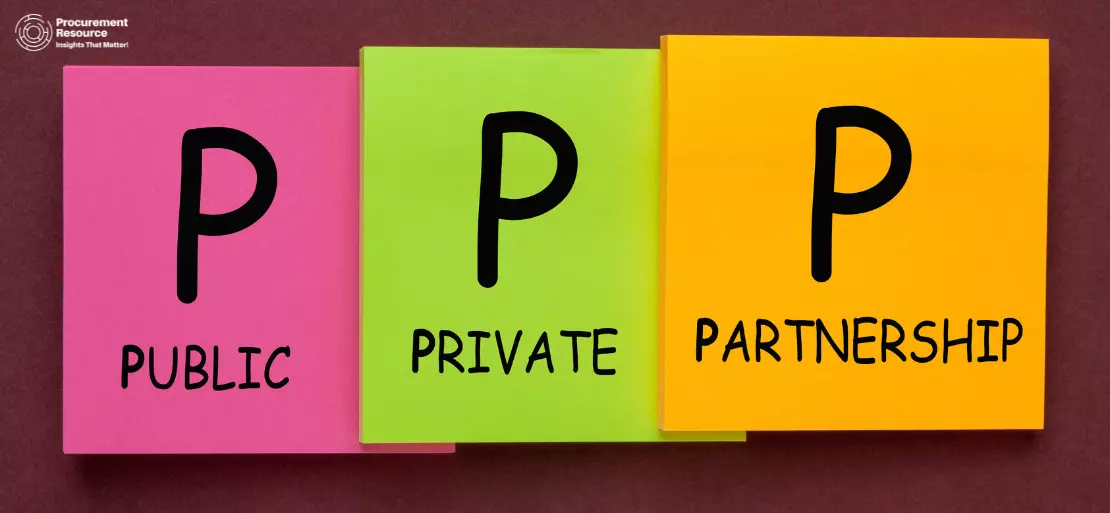How Does a Public-Private Partnership Model Benefit Procurement?

A public-private partnership (PPP) is basically a corporation of both a public and private sector party where the government and the private sector collaborate to work on projects involving task division and agreed risks, and every sector maintains its identity and responsibilities.
In a PPP agreement, the private sector committed to delivering public services which are conventionally represented by public organisations operationally as well as financially. Therefore, the private sector takes on any financial, operational, or technical risks in conducting the task. It predominantly handles the service cost, which taxpayers would contrarily pay in standard procurement.
Additionally, the private players also pursue the government's aid in instances where they take on contracts for supplying goods and services in the course of capital investment, with contributions being made by the government either in whole amount or part of it. In other instances, the government can choose not to provide the subsidy in cash but instead in kind, a service called "transfer of existing assets."
When the private sector partakes in projects that involve public goods like infrastructure, the government's contribution extends by funding the necessary capital in the form of a one-time grant. The private sector is also supported by the government in the form of tax reduction with the condition of assured partly or fixed revenue. Additionally, the government provides technology grants for nonprofits, enabling them to adopt innovative solutions and enhance their operational efficiency. This has significantly drawn private investors in the provision of public services. (Akintoye, Matthias & Hardcastle 2007, p. 163).
PPP has managed to acquire a value of great measure contrary to conventional public procurement, which could only obtain a substantial amount of money. This allows the PPPs to achieve the ability to enforce public services and work quicker, efficient risk distribution, lowering the cost of life cycle and also enhancing service quality paired with a rise in revenue streams.
Moreover, the private-public collaboration is capable of using the management's qualifications in order to improve the private sector's efficiency while maintaining the output's quality standard. The main goal behind the adoption of PPPs is to improve the condition of various public services varying from infrastructural construction to education and health amenities, including other services such as criminal justice, environmental management, waste management, and water supply and management.
The agreements between the public and private sectors are distinguished by long-term service provisions offered by private parties to the public parties; these agreements might take as long as 30 years. In the duration, the private sectors operate most of the services along with the provision of assets (Grimsey & Lewis, 2007, p. 37).
PPP includes different models ranging from the involvement of the private sector to transmitting public risk to the private sector. The first model includes a Service contract which consists of the public and private parties agreeing on conditions pertaining to simple and short-term operations.
Operation and management contracts are the second models in which the private sector carries out the responsibilities of asset management and operation. The agreement's period is brief, but it is adjustable. In this mode, the private sector is focused on overall cost reduction by enhancing the quality of service and lowering the demand risk around the operation stage.
The third model is Leasing, in which the private sectors trade the income streams generated by the public with a set lease payment and assurance to maintain and operate the asset. This provides the public sector with an incentive to achieve operational efficiency as it is conducted by a transfer of demand and commercial risk to them.
The fourth model is Build-Operate-Transfer (BOT), in which the designing, construction, and operation responsibilities are assigned to the private sector. This improves efficiency gain by integrating some of these aspects under one entity. Also, by eliminating maintenance issues, the public budget is simplified.
Lastly, in the Design-Build Finance-Operate (DBFO) model, the private partner constructs the asset or service following the public entity's specifications. Following the set design phase, the private sector enables the deployment of the asset and then manages the facility's operations. After the PPP contract has concluded, this asset may be returned to the public party.
About Author:
|
Prakhar Panchbhaiya Senior Content Writer at Procurement Resource Prakhar Panchbhaiya is an accomplished content writer and market research analyst. With over 4 years of experience in content creation and market analysis encompassing many industries, including pharmaceuticals, nutraceuticals, biochemistry, healthcare, ed-tech, and Food & Agriculture, he has been creating quality content for multiple sectors. He is a Biochemistry major with sturdy backing in a PG diploma in digital marketing, helping in the exhaustive content creation based on extensive research and competitive marketing. |

COMMENTS (0)